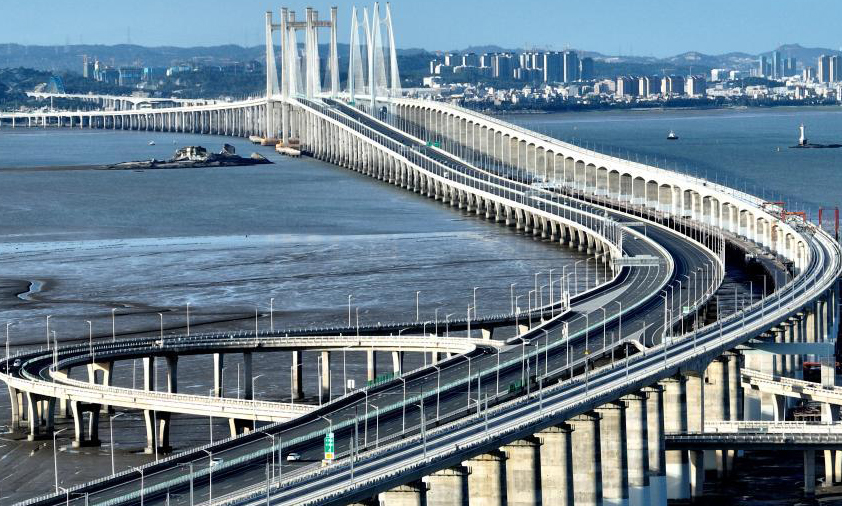China's environmental inspections pave way for green development
BEIJING, July 6 (Xinhua) -- China's two nationwide inspections on ecology and environment in seven years have pushed forward its drive for green growth by tackling pollution problems, strengthening ecological conservation, and promoting sustainable development.
Chinese central authorities started the scrutiny in late 2015 and finished the first round of inspections in vast local regions by 2018. The second-round inspections expanded its coverage to over 30 provincial-level regions, two government departments, and six centrally administered state-owned enterprises from 2019 to the first half of 2022.
The inspections, with the highest standards and largest influences on the country's ecology and environment oversights, have coordinated efforts in cracking down on ecological damage and facilitating green growth.
TARGETING MAJOR ISSUES, ADDRESSING PUBLIC CONCERNS
Based on a problem-oriented principle, the inspections have made it a priority in handling both major environmental issues and problems with prominent public concerns.
So far, 95 percent of the 3,294 problems revealed in the first round of scrutiny and its review period have been rectified, and half of the 1,227 issues already found in the second round of inspections have also been solved, Vice Minister of Ecology and Environment Zhai Qing told a press conference on Wednesday.
Aiming to solve environmental problems closely related to people's lives, China accepted and handled 287,000 complaints from the public during the inspections and has made 285,000 rectifications so far, Zhai said.
These inspections have a particular focus on typical problems. Some 262 cases have been released to the public, of which nearly half relate to pollution and weak links in environmental infrastructure, and 33.2 percent are in the field of ecology and sustainable development.
"When choosing typical cases, we paid special attention to problems causing severe pollution with pressing concerns of the people, such as malicious discharge of pollutants into waters and illegal dumping of large amounts of industrial waste in rivers," Zhai said.
"We also stressed acts that harm the ecology and hamper sustainable development," he added, giving examples including illegal construction in protected areas, unlawful land reclamation at seas and lakes, deforestation for housing, and illegal mining.
In 2021, the average concentration of PM2.5 in Chinese cities at or above the prefecture-level decreased by 34.8 percent from 2015, while the proportion of surface water with good quality and forest coverage rate reached 84.9 percent and 23.04 percent respectively, according to the Minister of Ecology and Environment.
PM2.5 reading is a gauge monitoring airborne particles of 2.5 microns or below in diameter.
PROMOTING GREEN DEVELOPMENT
Instead of simply addressing problems found during the inspections, more efforts have been made to ramp up high-quality development which is environmentally friendly.
Zhai noted the change at Ma'anshan, an eastern Chinese city on the bank of the Yangtze River. Occupied by a large number of illegal small mining firms and wharves, the pollution on the banks of the section used to arouse pressing public concerns.
With problems exposed during the inspections, the local government closed a large number of illegal wharves and companies with high pollution. At the same time, it built a number of wetland parks and riverside green corridors, which became popular sites among local people.
Under the guidance of the inspection team, the city also accelerated the building of industrial clusters of advanced materials and intelligent equipment manufacturing, coordinating high-level environmental protection with high-quality industrial growth.
Since environmental protection has been consistently placed high on China's regional development agenda, inspection teams also paid special attention to regional ecological conservation, Zhai said.
The teams focused on issues related to fishing bans, shoreline protection, water ecology protection and restoration, and pollution prevention and control in provinces and municipalities along the Yangtze River while prioritizing issues related to water shortage in the Yellow River region.
To promote the green transformation of economic and social development, the inspection has stressed projects with high-level energy consumption and emissions in the second round, Zhai added.
"In recent years, local awareness for green growth has improved significantly," he said. "A number of illegal projects were investigated and dealt with in accordance with the law, some traditional industries were upgraded, and a batch of green industries registered faster expansion."
Photos
Related Stories
- China criticizes U.S. attempt to ban Dutch chipmaking tech exports to China
- China mulls releasing pork from state reserves
- Over 17,000 caught for drunk driving in two-day nationwide crackdown
- China sees hottest June in over 60 years
- China's economy expected to improve amid supportive policies in H2: report
Copyright © 2022 People's Daily Online. All Rights Reserved.









